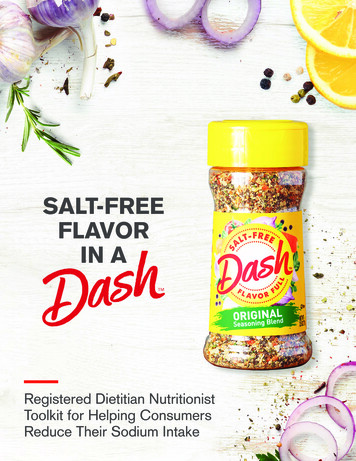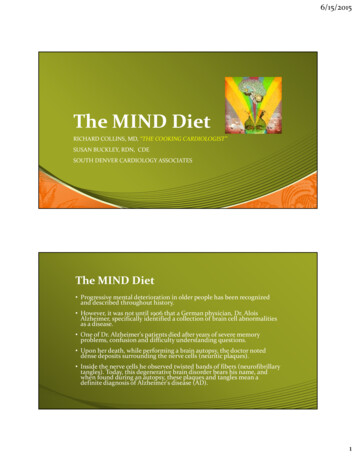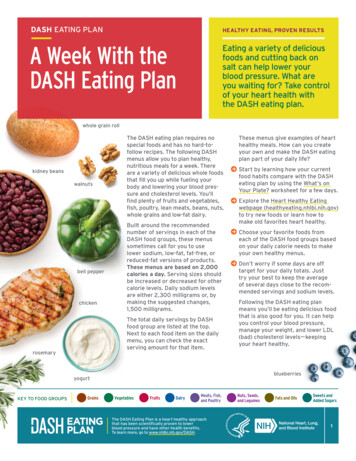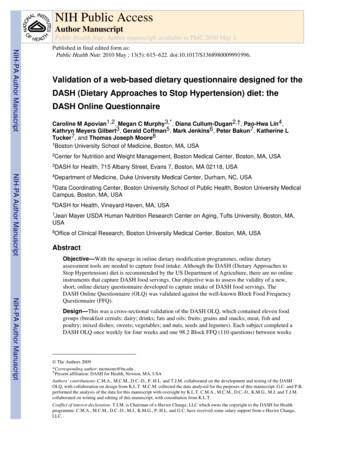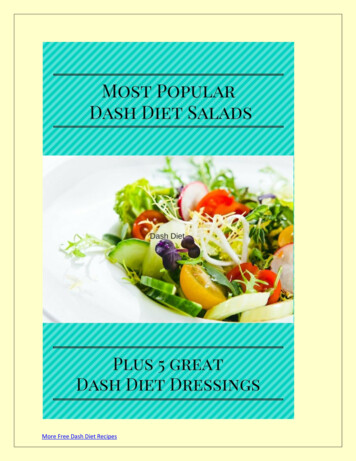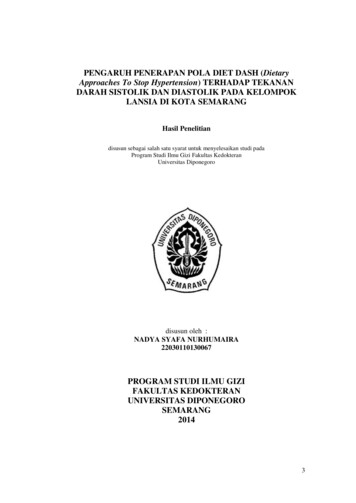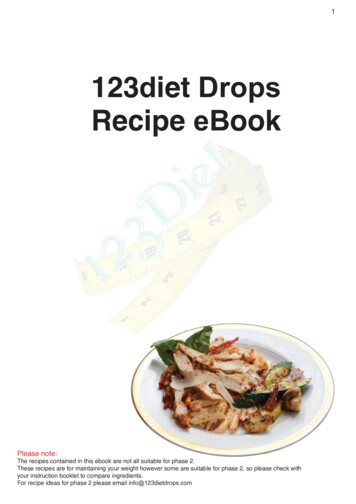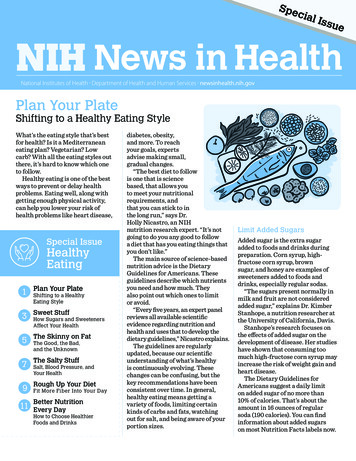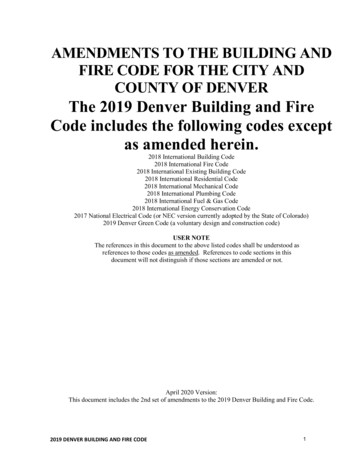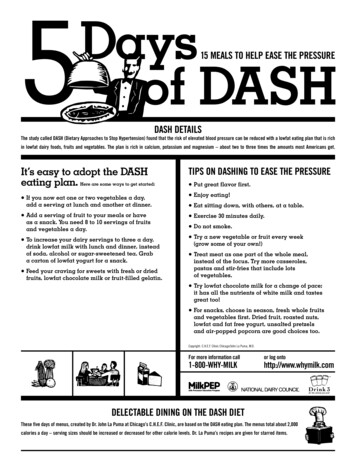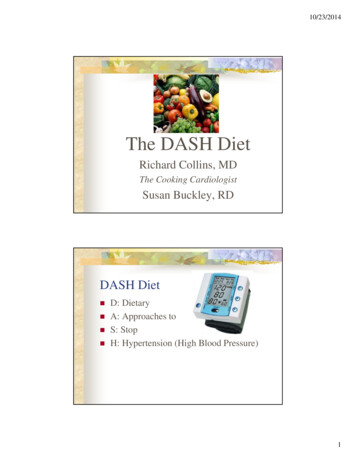
Transcription
10/23/2014The DASH DietRichard Collins, MDThe Cooking CardiologistSusan Buckley, RDDASH Diet D: DietaryA: Approaches toS: StopH: Hypertension (High Blood Pressure)1
10/23/2014Hypertension (HTN) Prevalence 50 million hypertensive US adults – about1 in 4 adultsOne-third unawareLess than half of American adults haveoptimal blood pressureHypertension As many as 2.8 million children also havehigh blood pressure.The prevalence of hypertension increases withage.2
10/23/2014 Untreatedhypertension can result in: Arteriosclerosis Heart Attack Enlargedheart--Kidney damage--Stroke--Blindness3
10/23/2014Hypertension – High Blood Pressure HTN means increased pressure in bloodvessels: less space for blood to travelthrough4
10/23/2014Prevalence of Hypertension by Age Age 18-2930-3940-4950-5960-6970-7980 % Hypertensive 41121445464655
10/23/2014Hypertension When the normal regulatory mechanismsfail, hypertension develops.Hypertension is so dangerous because itgives off no warning signs or symptoms.The “silent” diseaseFactors Influencing the Development ofHypertension High-normal blood pressureFamily history of hypertensionAfrican-American ancestryLifestyle smoking6
10/23/2014Factors Influencing the Development ofHypertension Excess Consumption of SaltCertain segments of the populationare ‘salt sensitive’ because theirblood pressure is greatly affected bysalt consumptionSalt vs Sodium Salt is sodium chlorideBoth are mineralsSalt is made up of 40% sodium and 60%chlorideIt's that 40% sodium that causes so muchconcern7
10/23/2014Sodium The 2010 Dietary Guidelines for Americans recommendlimiting sodium to less than 2,300 mg per day.1,500 mg if you know you suffer from high bloodpressure, kidney disease, or diabetes.The average daily sodium intake for Americans aged 2years and older is more than 3,400 milligrams (mg)Reducing average population sodium consumption by400 mg has been projected by the Centers for DiseaseControl to prevent up to 28,000 deaths from any causeand save 7 billion in health care expenditures annuallyWho is Salt Sensitive? Experts disagree as to the exact definition and cause ofsalt sensitivity but the chief symptom is blood pressurethat is unusually sensitive to salt or sodium intake.Salt sensitivity is especially common among older people,African-Americans, and people with hypertension, kidneydisease or diabetes.Overall, 26% of Americans with normal blood pressureand 58% of those with hypertension are salt sensitiveSo far there's no easy way to test for salt sensitivity—orits absence (though researchers seem to be narrowing inon a "salt gene8
10/23/2014What about Iodine? Recent research suggests that iodine deficiency isn't asrare as it once was.Adults need 150 micrograms a day, which we used to geteasily from our diet from iodized saltBut in recent years, some of our main sources—restaurantand processed food—are less likely to contain iodizedsalt.We also get iodine from fish, shellfish, strawberries,yogurt, cow's milk, and eggs. Kelp contains the most, sosushi eaters get plenty.Blood Pressure and Minerals But it's not enough to just lower sodium.Too much sodium really does boost blood pressure, buthigh blood pressure really responds when you restore thenatural mineral balance your body needs for healthy BPregulation.The perfect mineral ratio:1,500 - 2,300 milligrams of sodium4,700 milligrams of potassium,1,200 milligrams of calcium420 milligrams of magnesium.9
10/23/2014Mineral Intake and HypertensionCalcium American Heart Association Statement:Increasing calcium intake may preferentiallylower blood pressure in salt-sensitive peopleBenefits more evident with low initialcalcium intakes (300-600 mg/day) Percentage Meeting 100% of AI for CalciumCalcium Intake % of st5040302019rdeun111toto52danto1265o3t1rdeUnMales and FemalesFemales.10
10/23/2014Calcium But don’t just pop a pillEvidence from research shows that gettingcalcium from food rather than asupplement is best for blood pressurecontrol and a healthy heartCalcium: The most abundant mineralin the human body Low intake of Calcium: In theNurse’s Health Study, consuming the RDAfor calcium (1200 mg/day) resulted inlower risk of developing hypertension thanconsuming lower levels (400 mg/day).Good sources of Calcium: yogurt,sardines, salmon, tofu, spinach, kale, milk11
10/23/2014Effects of increasing Calcium-Rich Food Increases urinary sodium excretionDecreases blood volumeDecreases peripheral vascular resistanceDecrease blood pressureCalcium A University of South Carolina review of the healthhistories of 17,030 Americans found that those who gotmore calcium from food had lower increases in systolicblood pressure, an indicator of artery health, as they aged.In contrast, relying on supplements might cause trouble.In a National Institutes of Health study that followed388,229 women and men for 15 years, researchers foundthat men who took 1,000 mg or more of supplementalcalcium daily had a 20% higher risk for fatal heartdisease.However, calcium from food didn't raise risk.12
10/23/2014Calcium 99% of your body's calcium is stored in your skeleton andteeth, the remaining 1% circulates in your bloodstreamand moves in and out of your cells on an importantmission.Calcium helps blood vessels contract and expand; it alsoaids the transmission of signals in nerves and cells.These tasks are so important that if blood levels ofcalcium are low, your body will rob calcium from yourbones to make sure they happen.Calcium When calcium intake is low, artery wallscan tighten.Calcium also helps your body maintain ahealthier sodium balance; low levels ofcalcium hamstring efforts to off-loadsodium.13
10/23/2014Calcium When combined with low-sodium and high potassium,calcium's blood pressure punch is bigger.In the DASH study: "Dietary Approaches to StopHypertension," people who ate foods rich in both calciumand potassium (along with magnesium) saw bigger BPdrops than those who skipped calcium-rich dairyproducts.At the end of the study, 70% of volunteers on thecombination diet had lowered their blood pressure tohealthy levels, compared to just 45% of those who ateloads of produce but didn't add daily calcium-rich dairy.Calcium Best calcium intake for bone and hearthealth:1,200 milligrams a day, the amountrecommended by the Institute of Medicinefor people over age 50.14
10/23/2014Food Sources of CalciumFoodAmountCalcium (mg)Yogurt, plain, low fat8 oz415Collards, frozen, boiled1 cup357Skim milk1 cup306Black-eyed peas, boiled1 cup211Canned salmon3 oz181Calcium-set tofu3 oz163Cottage cheese, 1% milkfat1 cup138Almonds1 oz70Blackstrap Molasses1 Tbsp172How Does Alcohol Affect BloodPressure? Drinking too much alcohol can raise bloodpressure to unhealthy levels.Having more than 3 drinks in one sittingtemporarily increases your blood pressure,but repeated binge drinking can lead tolong-term increases15
10/23/2014Alcohol If you have high blood pressure, avoid alcohol or drinkalcohol only in moderation. Moderate drinking isgenerally considered to be:Two drinks a day for men younger than age 65One drink a day for men age 65 and olderOne drink a day for women of any ageA drink is 12 ounces of beer, 5 ounces of wine or 1.5ounces of 80-proof distilled spirits.Factors Influencing the Development ofHypertension Lack of Exercise Less active individuals are 3050% more likely to develophypertension.16
10/23/2014Sample Hypertension ProgramCardioStrengthFlexibilityFrequency3-7x per week,2-3x per weekTo burn up to 2000kcals/week3x per weekIntensity40-70% VO216-20 repetitions,60-70% 1RMPoint of tensionDuration30-60 minutes1-3 sets 10 secondsModeAny type theyenjoyCircuit trainingActive, static,tai chiFactors Influencing the Development ofHypertension Other Dietary FactorsLow intake of Potassium: In populationstudies, dietary potassium and blood pressure areinversely related.High potassium intakes are associated withlower BP.Good sources of Potassium: sweet potato,tomato paste, white beans, yogurt, soybeans, tuna,banana, spinach, low-sodium tomato juice17
10/23/2014Potassium Keeps sodium from raising blood pressureby making kidneys excrete more saltPotassium can lower blood pressure by 3-4pointsExperts recommend 4,700 mg a dayTypical American gets roughly 2,3003,000 mg dayHigh Potassium Foods Potato 940 mgLow sodium V 8 juice 820 mgSweet potato 540 mgBanana 490 mgAcorn squash 450 mgSpinach 420 mgSalmon 3 oz 390 mgMilk/Yogurt 1 cup 370 mgPinto beans ½ cup 290 mg18
10/23/2014Potassium A low sodium diet will have greater impacton health if it is coupled with a diet rich inpotassium!Magnesium Low intake of Magnesium: Magnesium is a potent inhibitor of vascularsmooth muscle contraction and may play arole in blood pressure regulation as avasodilator.Good sources of Magnesium: halibut,almonds, cashews, soybeans, spinach,oatmeal, yogurt 19
10/23/2014Magnesium In two big Harvard School of Public Health studies of70,000 doctors and nurses, those with the highestmagnesium intakes had healthier diastolic and systolicblood pressure numbers.A University of Minnesota study of nearly 8,000 peoplefound that risk for hypertension was 70% lower inwomen with the highest blood levels of magnesium and18% lower in men with the highest levels.Magnesium Up to 45% of us currently shortchange ourselves of thisimportant mineral.If you take blood pressure drugs, you should know thatsome diuretics (water pills) can also cause magnesiumdeficiencies.Proton Pump Inhibitors (Prilosec, Nexium, etc) candrastically lower magnesium.Couldn't you just take a pill to make up the difference?Experts say the magnesium in food works better, in partbecause you get other pressure-lowering minerals at thesame time.20
10/23/2014The DASH Diet The Dietary Approaches to StopHypertension clinical trial (DASH)Diet rich in fruits, vegetables, and low-fatdairy foods, can substantially lower bloodpressure in individuals with hypertensionand high normal blood pressure.DASH is Unique Tested dietary patterns rather than singlenutrientsExperimental diets used common foodsthat can be incorporated intorecommendations for the publicInvestigators planned the DASH diet to befully compatible with dietaryrecommendations for reducing risk ofCVD, osteoporosis and cancer21
10/23/2014DASH Study Design 8-week randomization to one of three diets: Control Fruits and vegetablesCombination: fruits, vegetables and low fat dairyproductsEnergy intake adjusted to ensure constant weightSodium content of all three diets wasapproximately 3000 mg/daily (not low sodium)DASH Subject Characteristics Systolic bp 160 mm Hg Diastolic bp 80-95 mm Hg Average was 85 mm Hg459 randomized Average was 132 mm Hg133 hypertensive326 normotensive22 years and older50% women, 50% men29% untreated hypertensive: not currently takinghypertensive meds22
10/23/2014DASH Study Test DietsControl diet Modeled after the typical American diet37% fat, 15% protein, 48% carbsCalcium deficient – 443 mg/dayPotassium – 1700 mg/dayMagnesium – 165 mg/dayDASH Study Test DietsFruit and vegetable diet Similar to control diet in fat and proteincontent Included 8-10 servings fruits andvegetables Calcium – 534 mg/day Potassium – 4101 mg/day Magnesium – 423 mg/day23
10/23/2014DASH Study Test DietsCombination diet Similar to fruit and vegetable diet Low fat and cholesterol At least 3 servings of dairy foods Calcium – 1265 mg/day Potassium – 4415 mg/day Magnesium – 480 mg/dayControlled Feeding Trial 7-day menu cycle (21meals)4 calorie levels: 1600,2100, 2600, 3100Lunch/dinner consumedon-site weekdaysWeekend meals consumedoff-siteAdherence recorded24
10/23/2014DASH: Mean Systolic BPSystolic BP (mm 21ine12049DASH: Mean Diastolic ntion Week7aseline77BDiastolic BP (mm Hg)855025
10/23/2014DASH Author’s Conclusions Blood pressure reduction is rapidBlood pressure reduction comparable to drugsBP effect can be generalized to all AmericansDietary Ca/F&V effect independent of Sodium intakeWeight changeDASH has public health implications Preventive measure against hypertensionReduce stroke by 27% and CHD by 15%DASH-SodiumEffects on Blood Pressure of ReducedDietary Sodium and the DietaryApproaches to Stop Hypertension(DASH) Diet26
10/23/2014DASH-Sodium: Subjects 412 randomized57% women57% ethnic minoritySystolic BP of 120-159 mmHgDiastolic BP of 80-95 mmHg41% hypertensiveDASH-Sodium Trial: Study DesignSodium levels: Lower: 1500 mg/day; Intermediate: 2400 mg/day; Higher: 3,300 gherSodiumControl Diet, N 204Control DietDASH Diet, N 208LowerSodiumRun-in:11-14 ee 30-day periods, random order)27
10/23/2014DASH II Sodium134132130Systolic 128Blood126Pressure(mmHg) 124122ControlDASH120118High 3300 Intermediate2400Low 1500Sodium Levels (mgNa)DASH II Sodium90Diastolic 80BloodPressure(mmHg) 70ControlDASH60High 3300 Intermediate2400Low 1500Sodium Levels (mgNa)28
10/23/2014DASH-Sodium: Results At each of the three levels of sodiumintake, blood pressure was lower for thoseon the DASH diet than for those on thecontrol diet.Reducing dietary sodium lowered bloodpressure for both the control and DASHdiets in all participants.Largest reductions in blood pressure werefound with the DASH diet at the lowestsodium intake.Sodium ¼ teaspoon 600 mg sodium½ teaspoon 1,200 mg sodium¾ teaspoon 1,800 mg sodium1 teaspoon 2,400 mg sodium1 tsp baking soda 1,000 mg sodium29
10/23/2014Sodium NutsPotato chipsCheeriosBreadSodium Honey Nut Cherrios ¾ cup 190 mgCherrios 1 cup 160Cherrios 1 ½ cup 240Lay’s potato chips 1 oz 170 mgArnold’s Oatnut bread 2 slices 300 mgPlanter’s Mixed nuts (lightly salted)1 oz 45 mg30
10/23/2014Sodium Make your own saladdressing/marinadesMake your own stock and gravy instead ofusing bouillon cubes or granulesMrs. Dash spices and marinadesLow-sodium cookbooks and web sitesUse herbs/spices vs saltSodium When eating out, order foods that havebeen grilled, baked, steamed or poachedinstead of fried, battered or “smothered”Low-sodium canned soup (150 mg or less)Natural low-fat cheese vs processed cheeseUnsalted popcorn, rice mixes, etc31
10/23/2014Sodium Dehydrated onion soup mix (1 packet):3,132 mg sodiumSeasoned bread crumbs, 1 cup: 2,111 mgsodiumSoy sauce, 1 tablespoon: 1,260 mgBeef Bouillon cube: 930 mgSodium Subway tuna and cheese wrap: 1,310 mg sodiumWendy’s roasted turkey and Swiss cheese sandwich:1,530 mgPanera Bread French onion soup: 1,790 mgTaco Bell Southwest Steak Border Bowl: 2,330 mgStarbucks' Turkey & Swiss Sandwich: 1,140 mgSubway’s Spicy Italian: 3200 mgWendy’s Baja Salad 1,975 mgChipotle Burrito (chicken, black bean, fajita vegetables,tomato salsa, cheese): 2450 mgQudoba Naked Salad: 1185 mg32
10/23/2014Sodium vs Potassium Chloride Potassium chloride has no sodiumCan buy No Salt (potassium chloride) orLow Salt (1/2 potassium chloride and ½sodium chloride)DASH Reduces Homocysteine Levels Effect a result of diet high in vitamin B-rich milk andmilk products, fruits and vegetablesHomocysteine is a common amino acid (one of thebuilding blocks that make up proteins) found in the bloodand is acquired mostly from eating meat.High levels of homocysteine are related to the earlydevelopment of heart and blood vessel disease considered an independent risk factor for heart diseaseLowering homocysteine with DASH may reduce CVDrisk an additional 7%-9%33
10/23/2014DASH Reduces Cholesterol Total cholesterol 13.7 mg/dl LDL cholesterol 10.7 mg/dl HDL cholesterol 3.7 mg/dlDASH Diet Patternbased on a 2,000 calorie dietFood at or fat free dairy2-3Meats, poultry, fishless than 2Nuts, seeds, dry beans and peas4-5/weekFats and oils2-3Sweets5/ week*servings varied from day to day,average intake over a week close torecommended34
10/23/2014Killing many birds with one stoneDASH meets multiple dietaryrecommendations NIH-NHLBI-ATP III AHA USDA Dietary Guidelines NCI and AICR Surgeon GeneralTake Time for Some TLC Choose foods low in saturated fat Whole grainsFruitsVegetablesFat free or 1% dairy productsLean meats, fish, skinless poultryDried peas/beans35
10/23/2014Sodium: Are You Getting TooMuch? Main sources of sodium in the average U.S.diet:5% added while cooking6% added while eating12% from natural sources77% from processed and prepared foods36
10/23/2014Reducing Sodium in the Diet Use fresh poultry, fish and lean meat,rather than canned or processed.Buy fresh, plain frozen or canned with “nosalt added” vegetables.Use herbs, spices and salt-free seasoningblends in cooking and at the table; decreaseor eliminate use of table salt.Choose ‘convenience’ foods that are lowerin sodium.Reducing Sodium in the Diet When available, buy low- or reducedsodium or ‘no-salt-added’ versions of foodslike: Canned soup, canned vegetables, vegetablejuicesLow-fat cheesesCondiments like soy sauceCrackers and snack foods like nutsProcessed lean meats37
10/23/2014Food LabelsClaimAmountLow Sodium 140 mg/servingVery Low Sodium 35 mg/servingSodium Free 5 mg/servingReduced Sodium25% less than originalUnderstanding Sodium Terms: Reduced Sodium25% less38
10/23/2014Diuretics Diuretic drugs can deplete levels of:Calcium, Magnesium, PotassiumVitamins B1, B6, Vitamin CLow levels can lead to bone loss, musclecramping and weakness, irregularheartbeat, high blood pressure and nauseaCan cause confusion, memory loss,insomnia, fluid retention & fatigueNatural Diuretics Some foods act as natural diuretics:Asparagus, parsley, beets, grapes, greenbeans, leafy greens, pineapple, pumpkin,onion, leeks and garlicShould not replace diuretics but can helpand may keep need for high doses ofdiuretics to a minimum39
10/23/2014Summary Simple Changes: One at a Time Add one more vegetable per daySnack on a piece of fruit instead of a cookieBuy low fat/nonfat milk and/or yogurtUse garbanzo beans on saladsHave a 1/4 cup nuts as a snackSummary Maintain normal body weightReduce sodium intake to no more than 1500 mg/dayRegular physical activity – at least 30 minutes most daysof the weekLimit alcohol consumptionMaintain adequate potassium, calcium, magnesium intakeConsume a diet rich in fruits, vegetables and low-fat dairyproductsReduce saturated fat in diet40
10/23/2014StrategyApprox reduction in SBPDASH Diet8-14 mmHgSodium 1500 mg2-8 mmHgReduce Weight5-20 mmHg per 20#Physical Activity4-9 mmHg(30 min day)Limit alcohol2-4 mmHg(no more than 2 drinks per day for men and 1 forwomen)DASH website www.dashdiet.orgExcellent website for information onDietary Approaches to Stop Hypertension41
10/23/2014Resources American Heart Association Low-SaltCookbook, 3rd Edition: A Complete Guideto Reducing Sodium and Fat in Your DietResources 500 Low Sodium Recipes: Lose the salt,not the flavor in meals the whole familywill love by Dick Logue (Nov 1, 2007)42
10/23/2014Resources Website/blog: www.sodiumgirl.comLots of low sodium info and recipesLow sodium expert has written for San FranciscoChronicle, Ladies Home Journal, Women’s Day,Shape, Living Without, Arthritis Today, Alliancefor Lupus Research and Stanford HospitalCookbook: Sodium Girl’s Limitless Low-SodiumCookbookLet’s Get Cooking!43
10/23/2014 8 Sodium The 2010 Dietary Guidelines for Americans recommend limiting sodium to less than 2,300 mg per day. 1,500 mg if you know you suffer from high blood pressure, kidney disease, or diabetes. The average daily sodium intake for Americans aged 2 years and older is more than 3,400 milligrams (mg) Reducing average population sodium consumption by
